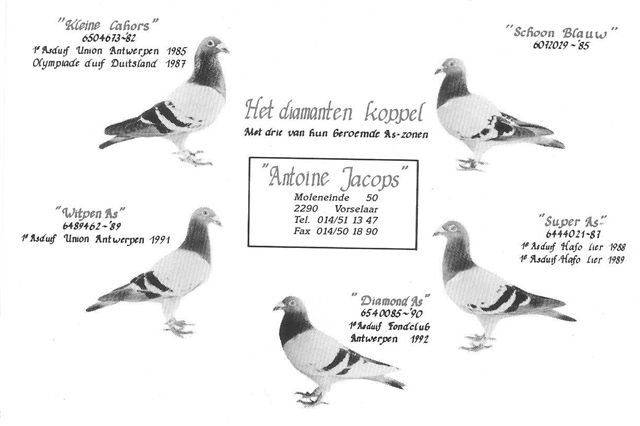
BLOG - June 2008
This past weekend's race was from Austin, Texas to Northeast Oklahoma at a distance of 400 miles or 640 kilometers. While it was clear in Texas, there were violent storms in Oklahoma. Saturday morning, it hailed about dime-sized chunks for about 30 minutes. The B Race was liberated at 7:30 am. Our first widowhood male clocked at 2:21 pm or 14:21 military time. He came from the northwest, banked slowly, and gently landed on the loft. He trapped quickly. I had been looking for the race birds between 3 and 3:30 pm. While his early arrival surprised me; it was not totally unexpected. The speed and consistency of the south winds of Texas often make predicting arrival times a guessing game at best.
AU 07 TEAM 351 won 1st prize West Tulsa Club and was 18 minutes ahead of the next competing loft, my dear friends at TNT Titans, Tony Smith and Josh Cooley; whose 4th place bird was also from the excellent pigeons of Antoine Jacops via LAMBERTON CUYPERS. We sent 6 birds and scored 1,2,3,6,7,8 in the club from 400 miles. Needless to say, I am very proud of the birds. 351's nestmate, 352, clocked 8th, 24 minutes behind her nest brother.
351 is line-bred to the DIAMOND COUPLE of Antoine Jacops.
I owned two children of the DIAMOND COUPLE that were super breeders. A male and a female. They are both now deceased. 351 is bred down from both of these incredible breeders. The KLEINE CAHORS was an Ace Pigeon and Olympiade winner. The SCHOON BLAUW was a daughter of the PLAYBOY (grandson of Karel Meuleman's original GOLDEN COUPLE) mated to a daughter of Antoine's original white male bred down from the incredible pigeons of Rene Maas.
Most of the racers on the race team have been bred down from the DIAMOND COUPLE. They are a combination of Antoine Jacop's old family of pigeons down from his original golden pair crossed on the tremendous pigeons of Karel Meuleman via Willy Van Berendonk. In the last twenty years, Antoine has crossed in the excellent pigeons of Tom & Karel Hufkens, the Van Laer Brothers, the Janssen Brothers, Flor Engels, and the full sister of the KANNIBAAL from the Van Dyke's, to the children and grandchildren of the DIAMOND COUPLE..
The results from the Combine, Federation, and State have been determined for last Saturday's 400 mile race. Kirk Hardin, Tri-County Loft, won 1st and 2nd prize in the State of Oklahoma with 670 birds competing. The 1st prize race winner was bred from two LAMBERTON CUYPERS pigeons. AU 07 KEYSTONE 7120, Red Check male, won the State race. 7120 was bred from two Antoine Jacops breeders. 7120's father, 1905, is a race winner for LAMBERTON CUYPERS. 7120's mother, 1165, has bred several excellent racers and race winners. Kirk has been racing pigeons for several years now. He follows the LAMBERTON CUYPERS race management system and races LAMBERTON CUYPERS pigeons.
This is the last week for racing Old Birds. The widowhood males exercised well during the week. Due to the heat and humidity in Oklahoma, it is critically important to keep the race team properly hydrated during the week as they exercise. I have been exercising them twice a day at 6:60 am and 6:30 pm. They exercise for about 2 hours in the morning and about an hour in the evening. I have appreciated the fact that the males seemed to peak at the end of the race season. Although they flew well throughout the entire race series, they saved their best for the distance races. Like last week, I expect good returns on Saturday. I will not send the 400 mile Club and Combine Race winner, 351, for two reasons. First, he is a yearling and will not race farther than 400 miles. Second, since he competed so hard last week, I do not think that he can duplicate his feat from either the 500 or 600 mile race stations. Next year is soon enough to race him again as a two-year-old widow. I did, however, send his nestmate female to the 500. I push the females harder than the males. I want to retire the best females to the breeding loft as soon as possible. So they are pushed during their first two years of racing. males are raced longer than females. I believe that good females or good females are the heart and soul of an excellent breeding program. In horses, cows, donkeys, dogs, chickens, etc., the females generally account for about 60% of the genotype of offspring. It is more important to breed good females than males since males only account for about 40% of a genetic package.
It is now time to separate the young birds, males and females, and begin to mate them to older pigeons. I will mate the old bird widows to the young females after they return this weekend.
Now that the 2008 OLD BIRD RACE SERIES is officially over, let's examine the race results based upon our race management strategy and procedures.
WEST TULSA CLUB RACE RESULTS
On Saturday, June7, 2008, the Northeast Oklahoma Racing Pigeon Federation concluded its last weekend of pigeon racing with two 500 mile/800 kilometer races from San Antonio, Texas (A & B) and one 600 mile 960 kilometer race from Kingsville, Texas. Consistent with the new policy that we adopted earlier in the Race Series, LAMBERTON CUYPERS did not play the 500 mile/800 kilometer A Race. (The reasons behind this decision were outlined earlier in the blog during the first few weeks of the 2008 Race Series.) We sent five old birds to the 500 mile B Race and 4 old birds to the 600 mile race. In the West Tulsa Club, LAMBERTON CUYPERS scored 1, 2, 3, 4 and 6 in the 500 mile race. In addition, LAMBERTON CUYPERS scored 1, 2, and 5 in the 600 mile race.
In the five long distance races of the season (400 - 600 miles), LAMERTON CUYPERS scored the following in the Club:
1. 400 mile/640 kilometer Alexandria, Louisiana Race - 5th prize.
2. 400 mile/640 kilometer Austin, Texas Race - 1st prize.
3. 500 mile/800 kilometer Lake Jackson, Texas Race - 2nd prize.
4. 500 mile/800 kilometer San Antonio, Texas Race - 1st prize.
5. 600 mile/960 kilometer Kingsville, Texas Race - 1st prize.
Cumulatively, these race results add up to 3 - 1st prizes, 1 - 2nd prize, and 1 - 5th prize in the five distance races.
AU 06 LAMBERTON 125 Blue male won 1st Ace or Champion Bird in the B Race Series.
AU 06 LAMBERTON 183 finished 2nd Ace or Champion Bird in the B Race Series.
Let's take a closer look at the performance of AU 06 LAMBERTON 125 whose name is TRAVELER. On May 3, TRAVELER scored 4th from 300 miles/480 kilometers. On May 10, TRAVELER scored 4th from 100 miles/160 kilometers. On May 17, TRAVELER scored 2nd from 500 miles/800 kilometers. On June 7, TRAVELER won the 600 mile/960 kilometer race. 120 miles - 300 miles - 500 miles - 600 miles - all in the span of a few weeks. I often am asked whether or not certain of our pigeons for sale on ipigeon or our website are short, middle or long distance pigeons. My usual standard reply is that there is no such distinction. In retrospect, I should qualify my answer to state that with the pfemaleomenal pigeons of Antoine Jacops, there is no such diversity. Antoine's pigeons race all distances. For Antoine and for me, the difference is in how they are prepared for the distance from which they are competing; rather than inherent breeding of a pigeon. TRAVELER played very competitively from 100 to 600 miles in the span of a few weeks. Consequently, the breeding and diverse racing ability of TRAVELER makes maintaining several families to compete at vastly different distances irrelevant. As I have stated before in earlier blogs, if 10 youngsters are bred from Antoine's pigeons, 2 may be better at the short distance, 2 may be better at the long distance, and 6 will be somewhere in between. TRAVELER is an incredibly strong pigeon that is easily motivated and very aggressive. So is his race mate, AU 06 LAMBERTON 69 that was 2nd club at the 600. Incidentally, 69 is pure Jacops breeding.
If you decide to select or maintain specialized racing pigeons, it may take 3 specialized pigeons for every one all-distance or Antoine Jacops pigeon on the race team. Personally, I don't have the time, money, energy or interest in keeping a large team of racers to compete from 100 to 600 miles in a race series.
Tony Smith & Josh Cooley, TNT Titans, racing LAMBERTON CUYPERS pigeons, won Champion Loft in the B Race Series.
Today, the 75 Combine race results are available. The 75 Combine is comprised of 4 clubs: GTO, TOK, Okmulgee, and West Tulsa. LAMBERTON CUYPERS won the 500 mile/800 kilometer B Race from San Antonio, Texas and the 600 mile/960 kilometer Race from Kingsville, Texas. The Kingsville race is one release and is figured in the cumulative results of the B Race Series. The 75 Combine results are as follows:
500 mile/800 kilometer San Antonio, Texas Race
600 mile/960 kilometer Kingsville, Texas Race
As you can see, LAMBERTON CUYPERS again won both races in the 75 Combine. TRAVELER and his race companion, 69, competed against 134 birds from 23 lofts spread out over 20 square miles (32 kilometers) in the Combine.
We raced 7 males and 2 females on widowhood. Interestingly, 352 won the 75 Combine 500 mile race one week after her nestmate won the 400 mile race in the 75 Combine. Quite a pair of nest mates. 352 and 351 are a product of a father-daughter coupling. Their father is the "714," CHECK ME OUT, male that is a son of a full brother to the SUPER ACE, DIAMOND ACE, WITPEN ACE, all from Antoine Jacop's DIAMOND COUPLE which appear on the following breeding card.

The KLEINE CAHORS, or SMALL CAHORS, a son of the CAHORS, was an Ace Pigeon the Antwerp Union in 1985 and won the Olympiade representing Belgium in 1987. The CAHORS was a tremendous racer winning the CAHORS race.
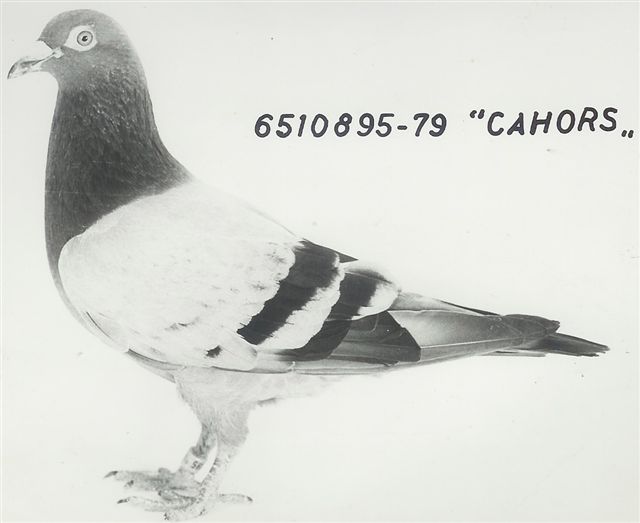
The female of the DIAMOND COUPLE is the SCOON BLAUW which means Beautiful Blue. She is a daughter of the PLAYBOY coupled with a full sister to the CAHORS. The PLAYBOY was bred by Willy Van Berendonk out of his tremendous son of Karel Meulemans GOLDEN COUPLE. As you may know, the GOLDEN COUPLE was a Van Den Bosch male paired with a Janssen female as shown below. Therefore, an important genetic component of Antoine Jacop's DIAMOND COUPLE is the Meuleman strain directly from Karel Meuleman's GOLDEN COUPLE.
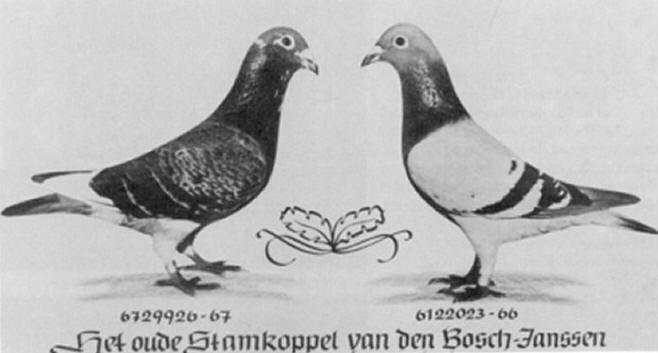
Each Antoine Jacops pigeon that has been bred down from the DIAMOND COUPLE has the blood of Karel Meuleman's GOLDEN COUPLE running through it. Antoine bought 3 identical Meuleman-bred brothers sired by Den 78000, the son of Meuleman's GOLDEN COUPLE, at auction from Willy Van Berendonk that were all prolific breeders: the PLAYBOY, the GESCHIFTE, and the WRONG WILLY. As you probably know, the Meulemans pigeons are some of the best pigeons in the world that have been crossed with many other types of pigeons and that have stood the test of time. The GOLDEN MATTENS is also down from the blood of Karel Meuleman's pigeons. Currently, I have been crossing these two families to spark the Meuleman genes present in both families: the MATTENS and the JACOPS.
Let's continue to analyze the Series-end results. The first LAMBERTON CUYPERS clock bird for each of the 10 2008 Old Bird Races are as follows:
1. Paris, Texas - 150 miles - AU 07 TEAM 351 - Blue male
2. Mt. Pleasant, Texas - 200 miles - AU O5 LAMBERTON 181 - Dark Check male
3. Fairfield, Texas - 300 miles - AU 05 LAMBERTON 169 - Dark Check Pied male
4. Alexandria, Louisiana - 400 miles - AU 06 LAMBERTON 123 - Blue male (Also clocked 2nd, Paris, Texas 150 mile A race)
5. Waco, Texas - 300 miles - AU 06 LAMBERTON 125 - Blue male
6. McKinney, Texas - 200 miles (shorted to Atoka, OK due to weather - 120 miles) - AU 06 LAMBERTON 125 - Blue male
7. Lake Jackson, Texas - 400 miles - AU 06 LAMBERTON 125 - Blue male
8. Austin, Texas - 300 miles - AU 07 TEAM 351 - Blue male
9. San Antonio, Texas - 500 miles - AU 07 TEAM 352 - Blue female
10. Kingsville, Texas - 600 miles - AU 06 LAMBERTON 125 - Blue female
In total, 6 race birds, 5 males and 1 female, clocked first in each of the B Series races. Another way of saying it is that 6 pigeons won the B Series Average Speed for LAMBERTON CUYPERS. 125, TRAVELER, clocked 1st 4 times - 351 clocked 1st 2 times - 123 clocked 1st twice, but one of them was the Paris 150 mile A Race - 352, 351's nest sister, clocked once. The other racers each clocked once. All of the widows older than 2007, except one, have enough points to be eligible for an AU Championship or Elite Championship.
As a footnote, 169 and 181, both of whom had enough points to be designated as an AU Champion, were lost on the 400 mile Alexandria, Louisiana smash race. As bad as this loss represents for LAMBERTON CUYPERS, a number of fanciers lost more than half of their race teams.
There were several other widows that flew well. The MAILMAN, AU 06 TEAM 324 Silver male, the full brother to the POSTMAN, the 2005 1st Ace Young Bird in the Federation, scored two 2nd prizes at 400 and 500 miles and a 10th prize at 200 miles. AU 06 LAMBERTON 183 Blue White -flight male scored 3rd at 400 miles - 4th at 500 miles - 5th at 120 miles - and 14th at 300 miles. PACER, AU 05 LAMBERTON 46 Blue male with over 200 AU points never did really come into form this season and perform like he has in the past. Although he flew well by most standards, he did not dominate his races like he has in the past. I may retire him to the breeding loft in 2009.
In my opinion, a good racer must clock in the top 10 or 20 pigeons multiple times to earn a spot on the LAMBERTON CUYPERS race team. Racers with only one or two head prizes are often removed from the team after their two-year-old year, if not before.
The LAMBERTON CUYPERS goal: to breed and compete with racing homers than score multiple times from multiple distances. This is the continual goal of Antoine Jacops; and this is our goal too. I think the results of the B Series races clearly demonstrates that it doesn't take a large team of birds to be competitive and to win; if you have the right pigeons and the right race management system. A few excellent pigeons will out-perform the race team of a mob flier racing 30, 40, 50 or more old birds.
The Jacops pigeons not only flew well for me this season, but also flew well for others. Steve King, Fast Lane Loft, flew well with his pigeons down from the imports of Antoine Jacops including his 2006 Ace Young Bird winner, 1459. As I previously indicated, TNT TITANS won the B Champion Loft Award with Jacops pigeons. Gary Williams flew well with the Jacops pigeons; and Kirk Hardin, Tri-County Loft, won the State of Oklahoma 400 mile race with a Jacops male. Both parents of his winner were on loan from LAMBERTON CUYPERS. Although I don't have the specifics yet, Bubba Wilson won 1st Champion Old Bird with a LAMBERTON CUYPERS-bred pigeon in his Club in Arkansas.
Yesterday, we talked about the number of pigeons it took to win the Average Speed Award in the B Race Series in the West Tulsa Club. To review, there were 6 widowhood racers that clocked first in 10 B Series races. Let's take a deeper look at these statistics. 125, TRAVELER, and 351, clocked first in 6 of the 10 races. In other words, 2 pigeons raced well enough that they completed 60% or 6 out of 10 races towards the Average Speed Award. A majority of the races necessary to win the ASA (Average Speed Award) were completed by 2 widowhood males.
What do these statistics say about the number of racers it takes to win Club awards? It indicates that (1) the better the homing pigeons and (2) the better the race management system, the fewer pigeons it takes to be competitive at the highest level of a pigeon club. In America, many pigeon fanciers believe that it takes a large race team to be a successful pigeon racer. In Europe, particularly Belgium, fanciers strive for quality pigeons and intense race management routines to succeed in the racing pigeon game. My bias comes from the fact that I have been taught how to play the game primarily from Mike Ganus and Antoine Jacops; although I have learned the nuances of the game from many successful fanciers in Belgium, including the Janssen Brothers, Jos Van Limpt "De Klak," Jos Thone, as well as many other famous and not-so famous pigeon fanciers.
What is a quality racing pigeon that will win head prizes more than once in a Race Series?
Here is an example:
TRAVELER
1st Ace Pigeon 2008 Old Birds - West Tulsa RPC
AU 2006 LAMBERTON 125
2008 Old Bird B Race Series Race Record - West Tulsa Club
1st prize - 600 miles/960 kilometers - 6.07.08 - 48 birds
2nd prize - 500 miles/800 kilometers - 5.17.08 - 66 birds
4th prize - 120 miles/192 kilometers - 5.10.08 - 88 birds
4th prize - 300 miles/480 kilometers - 5.06.08 - 61 birds
20th prize - 400 miles/640 kilometers - 4.26.08 - 139 birds
27th prize - 300 miles/480 kilometers - 4.19.08 - 153 birds
27th prize - 200 miles/320 kilometers - 4.12.08 - 139 birds
82nd prize - 150 miles/240 kilometers - 4.05.08 - 150 birds
To appreciate TRAVELER'S race record, the last race on the list is the first race of the season. As you can see by the date of the race, each race from the bottom up is the next race. TRAVELER raced 8 out of the 10 races in the B Race Series. Each week, TRAVELER raced better than the former week. From his initial effort of 82nd at 150 miles, TRAVELER raced his way in ten weeks to 1st prize at 600 miles.
TRAVELER'S pedigree can be seen by clicking on this link: TRAVELER. Hybrid vigor is often a result of the blending of two line-bred or in-bred colonies of pigeons. TRAVELER is a cross between two colony's of pigeons: the best racers of Antoine Jacops and Ad Schaerlaeckens. They key breeding couples in each of the two parental breeding colonies in TRAVELER'S pedigree are the DIAMOND COUPLE of Antoine Jacops and the parents of the GOOD YEARLING of Ad Schaerlaeckens.
As a breeder, TRAVELER can be crossed on the pigeons of Antoine Jacops or Ad Schaerlaeckens. Since Janssen pigeons and Meuleman pigeons are also in his pedigree, he can also be crossed on these two families.
The 75 Combine and Northeast Oklahoma RP Federation results are now available. A summary of the series-end totals for LAMBERTON CUYPERS
are as follows:
75 COMBINE B RACE SERIES ONLY
2nd Loft - Average Speed
1st Ace or Champion Bird - AU 2006 LAMBERTON 183 Blue White-Flight male
2nd Ace or Champion Bird - AU 2006 LAMBERTON 125 Blue male
5th Ace or Champion Bird - AU 2006 TEAM 324 - Silver male
75 COMBINE OVERALL RESULTS - A & B SERIES COMBINED
Average Speed - Not Eligible
1st Ace or Champion Bird - AU 2006 LAMBERTON 183 Blue White-Flight male
2nd Ace or Champion Bird - AU 2006 LAMBERTON 125 Blue male
4th Ace or Champion Bird - AU 2006 LAMBERTON 123 - Blue male
6th Ace or Champion Bird - AU 2006 TEAM 324 - Silver male
NORTHEAST OKLAHOMA RACING PIGEON FEDERATION B RACE SERIES ONLY
4th Loft Average Speed (2 minutes and 1 yard per minute behind 3rd place winner ROC & DEB)
2nd Ace or Champion Bird - AU 06 LAMBERTON 125 Blue male
3rd Ace or Champion Bird - AU 06 LAMBERTON 324 Silver male
6th Ace or Champion Bird - AU 06 LAMBERTON 123 Silver male
8th Ace or Champion Bird - AU 06 LAMBERTON 183 Silver male
NORTHEAST OKLAHOMA RACING PIGEON FEDERATION A & B RACE SERIES COMBINED
Average Speed - Not Eligible
2nd Ace or Champion Bird - AU 06 LAMBERTON 125 Blue male
3rd Ace or Champion Bird - AU 06 LAMBERTON 123 Blue male
4th Ace or Champion Bird - AU 06 LAMBERTON 324 Silver male
8th 4th Ace or Champion Bird - AU 06 LAMBERTON 183 Blue White-Flight male
LAMBERTON CUYPERS won 2nd Loft Average Speed in the 75 Combine with 28 Lofts competing and 4th Loft Average Speed in the Northeast Oklahoma Racing Pigeon Federation with 59 Lofts competing. Considering the number of races that favored the western side of the Federation, I am very pleased with the results.
We are happy to maintain a transparent website in which we put our pigeons, our race management system, and our passion to compete on trial during the 2008 Old Bird Race Series. The past weeks and months, we have detailed our time-tested race management system - procedure by procedure - and day by day. We have also detailed the pedigrees and overall quality of the race team. Now, we have the race results of our performance. We believe both our results, as well as the results of others who race our pigeons, confirm the fantastic quality of our pigeons, the quality of our race management system, and the quality of our effort to race competitively in areas in which racing pigeons is taken very seriously.
Pigeon by pigeon, the Antoine Jacops pigeons are the best racing and breeding pigeons in the world. Antoine's pigeons race very well everywhere they compete. Antoine sells most of his pigeons in Asia, the world hotbed for gambling and pigeon racing. Why? Because the Asians win money racing the Jacops pigeons. Why are the Jacops pigeons superior racing homers? Because Antoine's original family of pigeons beginning with a white male down from the fantastic pigeons of Rene Maas were the very best racers in the area; and he has only crossed fantastic proven pigeons into his original strain. Also, Antoine knows how to couple his pigeons to maximize prepotency and hybrid vigor. Although I have tried to minimize the amount of the blog devoted to marketing the Jacops pigeons, I don't know of any other loft worldwide who maintains the superior type of website that we maintain at drjohnlamnberton.com; a website that reveals our race management system, details the breeding of our pigeons, and reports our race results at the Club, Combine, Federation, and State levels.
We back up the quality our pigeons and the rigor of our methods with proven race results.
Now that Old Birds has concluded, we can turn our complete attention to the young bird race team. Tomorrow we will begin that journey.
Today is the birthday of our middle son, Jeremy. Happy 30th Birthday Jeremy!!! Jeremy takes all of the photographs and videos associated with the pigeons. I believe his work is as good as any pigeon photographer out there - anywhere. Thank you Jeremy.
The past week, I have tried to correlate our race results with our race management system. This past 2008 Old Bird Race Series, I detailed my philosophy and training methods before and during the race season. then, we analyzed the results. As I indicated last time, I believe the results clearly confirm the quality of our pigeons and the rigor of our race management strategy.
However, we should now turn our attention to the 2008 young birds. To review, our young bird team was bred in January and February. Why? Because our motivational system, widowhood, is based upon sexual maturity. In general or as a rule, the older the young birds the more sexually mature the team. My preference is to race January 1 hatches. But young birds bred through February usually make good racers. Depending upon the pigeons, any age pigeon that demonstrates a mature and consistent sexual maturity can be eligible for the young bird race team. Besides sexual maturity, I generally like a young bird race team that has been trained at the same time and that are in a similar stage in the moult of the flight feathers.
I have separated the males and the females. While there are a few young birds that defy a knowledge of their sex, I believe I know the correct sex of most of the team. There are about 20 females and about 18 males on the primary race team. While I started with about 150 young birds, the number of young birds, 38, is still far too many. I prefer a team of about 12 males and 12 females. Remember, I mate the young females to old males and the young males to old females. Why? Because the fastest way for pigeons to learn a human race management system is by modeling the behavior of other pigeons. Pigeons can learn training procedures in 24 hours if the learn the procedures from modeling another pigeon or pigeons. If they have to learn something on their own through repetition, it can take one to two weeks for a pigeon to learn a required behavior. And, the teaching method is far more difficult if I have to teach the procedure versus using previously trained old birds to teach young birds what to do.
Old males quickly teach young females all about the loft section, the nest box and bowl, and the feeding and drinking procedures. The same is true for old females and young males. A loft of young males that is wild, uneducated and undisciplined will dramatically and completely change in 24 hours if the young males are mated to old females. Old females "settle" young males - almost instantly; but certainly in 24 hours. It's amusing and awesome to watch if you have not seen this "settling" pfemaleomenon before.
Now that the sexes are separated, I am gently and quietly exposing the young females to the loft of widowhood males for brief periods of time, i.e., several hours at a time. This procedure allows the males to select a young female that they will enjoy and feel close to. I am also introducing old females into the loft of young males; after the young males have selected and bonded to a nest box.
I will take the young birds are one or two more long tosses, up to 90 miles, to try to reduce the number of young birds on the team. As a result of these tosses, I am not simply looking for pigeons that do not return from the toss; but instead am trying to statistically determine the fastest and most mature young birds on the team? Why? Because a race team of 24 young birds is far easier to care for than a team of 38.
Very soon, I want to cut and pull the 10th, and possibly the 9th, flight feathers so that the young birds will have a full wing on the first young bird race. I do not road train during the time the young birds are missing one or two important primary flights that I have removed from their wing. It generally takes about 3 weeks for the primaries to grow back into the wing. I don't want to damage these new flights while they are growing into the wing through too much training. One the wing is full, the rigorous road training an again commence. If you have used the light system, and have bred early youngsters, you may not need to cut and pull any flight feathers. I merely do it as a precaution for those young birds who may not finish the moult by the end of the first week of September. The advancement of the moult is dependent upon where the loft is located geographically and when or how early the young bird season begins on the calendar. The earlier the young bird races start, the more the necessity to control the moult of the primaries through lighting or through cutting and pulling.
So, today, I am concerned with several areas of the race management system:
1. Sexing and separating the young bird team.
2. Mating the young birds to old birds.
3. Teaching the young birds the widowhood motivational system through "modeling" an older mate's behavior.
4. Reducing the numbers of young birds on the race team from 38 to 24.
5. Controlling the moult so that the young birds will have a full wing on the first young bird race in early September.
As a preparation for early to mid June, for the past two months, I have been loft training the young bird race team everyday as well as road training the young birds (1) frequently (2) to short distances (3) in many directions: north, south, east and west.
Every day I am constantly looking for reasons to eliminate young birds from the team. First, I handle them. As they are trained and as they mature, their muscles should develop physically and young birds should become more physically mature and robust. Second, I observe them visually. They should begin to look more like old birds. Their eyes should change, mature, and become clear and colorful. Their wattles should become more prominent and certainly snow white. And their feathering and plumage should become shiny, clean and full. They should be medium-sized, not too big and not too small. They should stand in a balanced manner, not too tall and not too squatty. I don not like pigeons that grunt. I don't like "flight" or wild young birds to race. On occasion, I will keep one as a breeder in hopes that their eventual maturity will calm them down. Finally, young birds should readily and easily mate to older pigeons. I do not race young birds that remain sexually inactive. It's not that their not good birds. It's simply because they don't "fit" or conform to my young bird race motivational system. when I see sexually mature young birds that readily want to mate, it is usually a good sign that these young birds will make great young bird racers.
This morning, it is raining. The young females are out enjoying the rain and taking a bath. I like to teach young birds to fly in the rain around the loft. While I would never do this during the race season, it's okay to let the young birds enjoy the rain today.
I would like to print an email I received today from a friend:
Thank you Mandel. Your thoughts mean a great deal to me.
Last week, I posted several excellent 2007 breeders on ipigeon.com. I will repost several of them again today as well as about 10 or 12 super 2008 young birds. All of these birds will make good breeders and help anyone's loft at any distance - guaranteed. Example?:
AU 2008 LAMBERTON 194 - Blue Splash male (Sex not guaranteed) - Inbred to the Flor Vervoort 's PHANTOM owned by Mike Ganus.
SIRE: GLIMMERMAN - Double-bred Son of Flor Vervoort's PHANTOM owned by Mike Ganus.
DAM: GLIMMERGIRL - Daughter of Flor Vervoort's PHANTOM owned by Mike Ganus.

All of the 2007 and 2008 breeding prospects posted to ipigeon this week represent the cream of the breeding loft. Any one of them will add value and performance to your breeding loft.
It is still raining in Oklahoma and Tulsa. Yesterday set a single-day rain record in Tulsa for this time of the year. Since it is hard to exercise the young birds, the weather actually provides an opportunity to observe and handle the young birds on the race team. I let the young females into the widowhood loft with the old males and the old females into the widowhood loft for the young males. One of the key factors I use to select young birds to race is their reaction to the nest box, the nest bowl, and the opposite sex. Out of 20 young females and 20 young males, there will be a percentage of each that react very quickly to the opposite sex and begin to couple. These early "couplers" are often a sign of the best young birds on the team. As I have said many times before, performing well in races requires that pigeons "race" home rather than simply "fly" home. Motivation is the key element to stimulate pigeons to "race" home. The best motivation is sexual passion. Those young birds that demonstrate a strong sexual passion in June and July of their birth year are often the best young birds to race. Since it takes 4 to 6 weeks to properly teach young birds the widowhood system, I prefer not to wait on young birds to become sexually active in August or September. The young bird races begin in the first week in September in Northeast Oklahoma. I back up 4 to 6 weeks from the first race as a drop dead date to begin teaching the young birds the widowhood race system. Therefore, a drop dead date would be about August 1. However, I prefer young birds that can learn the widowhood system in June and July in order to stay away from the extreme heat that accompanies teaching them in August.
Today, I will stand in the loft and observe which young males and young females are coupling with their older counterparts. I will record their ring numbers and make notes of which old bird couples with which young bird. I close the nest front when a pair mates so that the remaining young birds will not be confused by those pigeons that have already paired. As the young birds couple, I close their nest fronts. The goal is to end up with every pair coupled in a closed nest box. KEY POINT: Those young birds that do not couple within about two weeks are removed from the team. It is not necessary to race every young bird that you raise in the young bird race series. It is more important to race 6 young females well than 18 young females in a chaotic situation. Those young birds that take longer to couple are eligible to race in old birds if you really want to race them.
Only select those young birds that quickly and easily respond to the race system; which in my case is the classic widowhood system. Normally, it doesn't take more than 12 birds to effectively compete in most Race Series. Since I am only racing the B Race Series in Young Birds, 12 pigeons or less are plenty of birds to race. Out of about 20 young females currently on the team, I will select about 12 of them to race in September. The intensity with which they respond to a potential mate is a very significant indicator as to the intensity with which they will race home. Last year, TNT TITANS, Tony Smith & Josh Cooley, had one of their best young bird series ever by racing 7 young birds. Tony remarked that "the chaos was gone" when he only raced 7 young birds on widowhood. There were both males and females in his team of 7 young birds. They mated the females to old males and the males to old females. Again, racing 7 pigeons very well on a specific race system is better than racing 40 pigeons as a wild flock - untrained and untutored. If you race a "flock" of young pigeons to their perch, you are not racing your pigeons in a system that maximizes their potential to "race" home instead of "fly" home.
KEY POINT: Each and Every young bird should be trained a well executed easy to learn race system that maximizes their ability to race home as a result of intense psychological motivation.
If you are not racing young birds to your satisfaction, do something radical. Since you are not racing well, what do you have to lose? Suggestion: Select your best 4 young birds and only race these 4. How do you select your best 4 young birds? Take your young birds 90 miles once or twice over the next two weeks. After these long tosses, you will know which of your young birds are the best. Select the birds that consistently come home within a short amount of time and race only these pigeons on a system of weekly motivation. I promise that your race team will perform much better.
KEY POINT: Only one pigeon can be first. In an 8 week young bird race series, you need 8 firsts, not 8 pigeons. Your best young birds will clock first multiple times if they are prepared properly. Why reduce the performance ability of your best young birds by making them live, train, and race with other young birds of a lesser quality? Every time you eliminate your poorest young bird, you will find that your race team will exercise longer than before. The weakest and poorest young birds will dumb down the entire race flock by influencing the race team to quit exercising earlier than the best pigeons want to. Often, when I begin training the young birds in March with 50 to 100 young birds, there will be a majority of them that will quit loft training and trap after about 45 minutes - while another 15 to 20 will continue to fly for at least another hour. In most cases, the best young birds are the last ones to quit training. The first young birds lost during road training will be the ones that train the least around the loft.
FACT: The best racers usually exercise around the loft the easiest and the most. There is a direct correlation between quality training and quality race results. Quality race birds are aerodynamic and healthy. Quality race birds love to fly, love their box, and love their mate. Select these young birds before the race series and only race these pigeons during the race series. It will cost less - take less time - you will get much more enjoyment from the sport - and you will perform much better in the game. Guaranteed!!!
Tomorrow is June 21, 2008. Dove season begins on September 6, 2008 in Oklahoma. Traditionally, the Young Bird Race Season begins the week after dove season begins. The rationale is that the amateurs will hunt the first weekend; and abate after that. The rationale is that professional hunters will hunt doves only while less sophisticated hunters will shoot anything in the air, including racing pigeons. I believe that the 2008 Young Bird Race Season will begin September 13, 2008 and continue for about 8 weeks. The Northeast Oklahoma Racing Pigeon Federation usually constructs a schedule of 2 - 100 mile races, 2 - 150 mile races, 2 - 200 mile races, and 2 - 300 mile races.
There are 12 weeks between tomorrow's date and the first young bird race. Each Saturday, beginning tomorrow, is an opportunity to simulate race conditions. Young Birds do not inherently know various motivational systems. They have to be taught motivational systems. Fanciers tend to confuse the homing instinct with a motivational system. So let's talk about the homing instinct. While most pigeons seem to be born with an ability to home, pigeons use their intelligence to activate or utilize their homing ability. Innate intelligence cannot be determined holding a pigeon. It cannot be determined by a pigeon grader. Although I like to use eye sign theory, I cannot evaluate intelligence with an 18 power eye loupe. Intelligence can only be measured by performance. That is, intelligence can be measured by how pigeons react and conform to components of a race system. What are these components? Let's look at my motivational system: widowhood.
I teach my young birds to live and eat in a nest box by using the same type of nest box in the race loft that is used in the breeding loft. During the first four weeks of their life, squeakers learn their environment, i.e., the internal world of their nest box which includes a nest bowl and feeding bowls. when they enter the race loft, they find the exact same physical environment from which they were weaned. Those young birds that recognize their surroundings, quickly choose a box, and vigorously defend their choice, are usually the most intelligent young birds in the loft. Those young birds that quickly and easily learn to trap into the loft are usually the most intelligent. Those young birds that quickly respond to a fancier's verbal cues like calling or whistling or using a whistle are usually the most intelligent. Those young birds that overcome their fear of humans and are easily tamed are usually the most intelligent. Those young birds that develop their sexuality in about four to six months are usually the most intelligent. And most obviously, those young birds that orient quickly and return home the soonest from a training toss are definitely the most intelligent young birds in the loft. In summary, responses to stimuli or overall reaction and cumulative performance to a motivational race strategy are visible benchmarks of a young bird's intelligence.
I like several characteristics of a great young bird:
First, I like a good looking young bird.
Second, I like a well-balanced young bird.
Third, I like a young bird that feels great in the hand and conforms to the physical characteristics that I prefer.
Fourth, I prefer a young bird with a beautiful eye and great eye sign - the way I understand it.
Fifth, I like a tame and gentle young bird. Wild young birds may make good breeders when they settle down; but seldom make great racers.
Sixth, I like a young bird that quickly responds to the tasks I introduce.
Seventh, I like a young bird that orients quickly and races home rather than flies home.
Eighth, I prefer a young bird with a great pedigree; a pedigree that demonstrates about 70% line-breeding and about 30% out-crossing.
By only choosing those young birds that generally conform to the 8 preferences listed above, I find that only about 10% of the young birds raised meet these criteria. Around Oklahoma, fanciers have been exposed to the Lamberton 10% Rule. This rule states that a majority of 10% of those young birds raised will make great racers. Interestingly, the percentage of young birds that make great breeders is much higher. I believe that about 30% to 40% of young birds raised can make good breeders. If you will calculate the number of young birds that clocked very high in the young bird race series, and divide it by the number of young birds raised, the resulting percentage will usually be 10% or less. There are, however, great breeding years when the number of quality young bird racers can be much higher than 10%.
Another way to state the Lamberton 10% Rule is to say that 90% of young birds raised to race in the young bird race series will not contribute to the top race results during the young bird race series. I believe that smash tosses are not necessarily bad. In fact, they are often inevitable. Smash tosses help fanciers eliminate the 90% of the race team that won't develop into top racers. On a bad training toss, I tell my fellow fanciers that if one bird came home, they all could have come home. If every young bird tossed is lost, then the fancier made a mistake and is responsible for the loss of the young birds. However, when the first bird returns, the fanciers are off the hook and no longer responsible for a bad toss.
KEY POINT: If one pigeon makes it home, then all the young birds could have returned from a training toss. If none of the young birds return, the onus is on the fancier for making a bad toss.
Recently, a friend took 49 young birds on a 30 mile training toss, releasing them at 6:50 pm., after letting them sit in the crate for about 15 minutes. After one hour, two young birds returned. At dusk, a third bird returned. It rained in the release area that night and it continued to rain until about mid-morning the next day. As the rain began to cease mid-morning, 4 young birds returned. In the next 24 hours, 32 young birds returned in total. 17 young birds were lost. In my estimation, this toss was great for my friend's young bird team. Because 32 young birds returned, all of the young birds could have returned. Losing 17 young birds reduces the amount of feed, water, and medication necessary to support the race team; and rids the loft of birds that will not contribute to top results necessary to compete at the top of the young bird race series.
However, let's examine this toss with the Lamberton 10% Rule. According to this rule, my friend should have expected 4.9 pigeons to quickly return from the toss. Instead, 3 birds returned that evening. Now, I believe that a percentage of those young birds that returned the next day may also make great racers. But in total, according to my Rule, my friend should expect the best 5 pigeons out of the 32 birds that returned to be his best racers. While 10% is a conservative average, my friend may actually end up with a higher percentage of quality racers. If 10 of the remaining 32 young birds make great racers, the true percentage of great racers for my friend in 2008 is 10/49 or about 20%.
I am currently training about 25% of the young birds that I raised in the first two rounds. I think this percentage is too high. After young birds, let's take a look at the final percentage of great young birds. It won't be 25%, I promise you.
What does this mean for you? I advise you not to try to race every young bird you raise. Select the best 10% to 20% of your young birds and race them on an effective motivational system. Please do not simply fly them to the perch as a large flock of uneducated and wild young birds.
Back to tomorrow, Morgan and I will take the young birds on a training toss of about 60 miles or 96 kilometers; and allow the young birds to return to their old bird mates. If I do this every week, by the first race, my young birds will have practiced the widowhood motivational system 11 times before the first race. They will have an eleven week summer class in widowhood in summer school at Lamberton University. On the first race, my young bird team will have flown 11 practice races and had 11 weeks to learn the widowhood motivational system. They will learn that they will find their mates in their nest box after returning from a race; despite being celibate all week long. Young birds cannot be adequately taught a motivational system in two or three weeks. It simply takes longer if you want to play at the top of the game.
when the price for a gallon of gas has skyrocketed, when the cost of a 50# bag of fee has increased 60% since the end of 2007, when the cost of utilities has dramatically increased (and will continue to increase), when people are working harder and longer and realizing less benefit or net dollars, when the ratio between the dollar and the euro has dropped (for the dollar), it makes little sense to me why fanciers race and house so many pigeons. Depending upon the Race Series, for the average fancier, a young bird team should not be larger than 24 young birds and an old bird team should probably be half of the number of young birds raced. The average fancier does not have the time to teach 24 young birds a powerful motivation technique. For me, it is hard to teach more than 12 young females and 12 young males the widowhood system with any degree of attention given to each young bird. Right now, I am training 14 extra pigeons. Over the next few weeks, I will remove 14 young birds from the team. It's too much work. I am not spending enough time with the very best young birds by spending time with birds that will not contribute to "head prizes" during the young bird race series.
Use the summer months wisely. Please don't wait until the upcoming young bird series begins to train your pigeons. If you wait, I believe that you will harvest what you sow. Playing the game of pigeon racing at the top of the race sheet if usually very difficult. You can make it more difficult than it already is by (1) racing a large young bird team and (2) waiting until the last minute to adequately train your young bird race team.
FYI: I have placed several excellent breeding prospects down from by son, the SHADOW, and daughter, FLICKER, of the PHANTOM for sale on ipigeon.com. These are excellent young birds that will make excellent breeders. One of them AU 08 LAMBERTON 194, is bred very well. Although I have him priced a little higher than many of the young prospects usually posted, he is worth far more than the posted price. Take a look at these pigeons. They are fantastic at any distance, including 600 miles.
On Friday evening, I basketed the young female race team in a regulation "Bobby Lephew" shipping crate. I kept the shipping crate over night in the bed of the pickup truck. I placed long thin water trays down the side of the crate that is built to allow the race birds to eat and drink. After splashing my fingers in the water trays and calling the females to drink, the females quickly came to the side of the crate and drank. I left the water trays in place next to the shipping crate over night. This simulated exercise will be repeated every weekend until the young bird race season commences in early September. I believe it is very important to spend a great deal of time during young bird training teaching the young birds know how to eat and drink in the crate.
Saturday morning, we took the young females about 50 miles south down the race course and let them return to the old bird widowhood race team. This exercise was a simulation of the first race. Whereas the distance was shorter than regulation races and the number of birds released was very small, simulating race conditions is an effective training technique for young birds and should be repeated as often as possible before the first race of the young bird race series. At some point in time, I will include several other fanciers in the training exercise. By adding the birds of several other fanciers, the young birds will learn to break along the race course. Further, if there are several young birds that break and return several minutes early, or other young birds that return home late, these training exercises often yield pertinent information about the performance of each of the young birds. Soon, I will "chip" the young females and let the computer record arrival times.
I train the young females very hard; while I take my time training the young males. Young females usually mature faster and earlier then young males. Therefore, they can absorb much more training and racing than young males with no short or long term ill effects. Depending upon the weather, I may stop racing the young males at the 200 mile race station during the young bird race series.
I continue to wonder how fanciers attempt to race a large team of young birds before they know how to race one young bird effectively. If a fancier ever had the courage to race six or less young birds during a young bird race series, the experience would change their lives as fanciers. I race a team of young birds that were all hatched in early January. I race the oldest possible race team and a team that is the same age. The age spread of my race team is always less than 30 days.
If you haven't done so, it is time to cut and pull the 9th and/or 10th flight; if your race season begins in early September as mine does. In summary, I am currently coupling the young birds with older mates, flying simulated training flights on Saturdays, and adjusting the wing moult of each racer. If the wing moult is advanced and looks like it will moult out naturally before the first race, I leave the wing along. If the wing moult is late or stalled due to heavy training, I will cut and pull the 9th and 10th flights. I adjust or manipulate the wing moult on a case by case basis.
The most important aspect of young bird training during the summer months before an early September race series commencement is regular and consistent repetition. No rocket science. No secrets. Just regular and consistent training. In order to save on gasoline, I train the young birds around the loft during the week - one hard hour training morning and night - and a long toss of 60 to 90 miles on Saturdays (race days). During this regiment, take notes about any "special" observations you make, i.e., good performances or bad performances. These notes will begin to "paint" a picture about the race team over time.
During the summer months of repetitious training, you will probably learn which birds will be your best racers and which birds should be removed from the race team. Keep reducing the number of young birds on the race team not only up to the first race; but through the race season as well. I have been taught to keep only the very best racers that may eventually become the key breeders in the breeding loft. Currently, there are 20 young females on the race team. I usually have selected 12 to 18 young females to race. This year has been a good breeding year and paring down to 12 young females may be more difficult than usual. I do think I can get down to 16 to 18 young females before the end of the summer.
After several race seasons using these training procedures, you will be able to select many of your best young birds very early in the year and without much training, if any. Several years of this experience will begin to de-mystify the illusive criteria of Young Bird Selection.
If, on the other hand, you leave your young birds as a large flock in a large section of your loft with perches and a large aviary with little training until several weeks before the young bird race series begins, the chances of winning young bird races or performing well in the race series approaches random chance. I would rather race one super young bird on classical widowhood than I would race a flock of 50 uneducated young birds to the perch.
YOU NEED TO THINK LIKE A PIGEON
If you want to have the greatest success training pigeons, it usually helps to think like a pigeon. when released away from home, pigeons don't always fly "straight" home. With a tailwind, pigeons often fly past the loft and return from an opposite direction than from the direction they were released. If a front of competing lofts is unusually wide or long, pigeons often "loop" into their loft from a horizontal direction. I have discussed this pfemaleomenon in an earlier blog. Because of this, I believe that it is important to train young birds around the clock or from all directions. Why? Because pigeons can and will return home from any direction. Although the Northeast Oklahoma Racing Pigeon Federation follows a race course to the south, I often toss young birds for the first time from another direction than the race course. As I have indicated many times earlier, I like a "thinking" pigeon rather than a "reacting" pigeon.
Pigeons, as well as all animals and humans, develop tendencies or habits very quickly. The brain is constantly categorizing experience and looking for similarities in each and every situation that it encounters. Routines or habits are much like a screen saver on your computer. Habits allow the brain to react rather than think. Habits equal reaction. Habits allow the brain to go into more of a rest mode than thinking requires. Often, this correlation is what you want to occur. Sometimes, albeit probably most times, the purpose of repetitive exercises is to create an automatic reaction through the development of habits. Orientation upon release is an instance in which I prefer a "thinking" pigeon rather than a "reacting pigeon. For instance, this past year, the French government refused to allow the Belgian Racing Pigeon Federation to release its early races in their country. In my opinion, this policy was a meaningless political reaction to the problem of the bird flu in Europe. Consequently, the KBDB scheduled the liberation of its early races in Germany. Generally, the flight path from Germany is more easterly while the flight path from France is southwesterly.
Because Belgian racing pigeons race almost exclusively from the southwest into France and Spain, upon release, they react based upon their normal routine and head northeast. when the race course was changed to release to the east in Germany, the Belgian pigeons reacted to their situation and headed northeast upon release rather than west as they should have to reach their lofts in Belgium. Many Belgian pigeons were lost in these early races in Germany. In my opinion, the reason they were lost is because most Belgian fanciers race pigeons that have never raced on any flight path other than to the northeast. Therefore, the Belgian pigeons reacted to their situation by heading north or northeast possibly racing to northern Holland or northern Germany instead of west into Belgium. The red lines on the map refer to the required flight paths from Belgium and Germany to find home. The purple block (parallel to the flight path from France) refers to the flight path the race birds probably took based upon their "reaction" to the release which was conditioned from a constant release from France.

In addition, it has been my experience that "thinking" pigeons orient more quickly and more accurately than "reacting" pigeons. "Thinking" pigeons have a tendency to break from the group more quickly and with more authority than "reacting" pigeons.
How do you create "thinking" pigeons. Since pigeons are constantly looking for routines, the training task is to reduce the number of times that a training toss is repeated from the exact same direction and location. In the 1988 article written by Bob Kinney mentioned earlier, I revealed that I normally train on a diagonal. That is, if I take the young birds on a training toss from the southwest in the morning training toss, I take them on a training toss to the northeast on an evening training toss. Repetitive training tosses are always repeated to the 180 degree opposite. It has been my experience that pigeons that are trained from the very beginning using this training method become far better homers and faster racers than by using any other training method. Speed is not simply a function of one pigeon racing faster than another. Speed is also a function of orientation ability, aggression and independence. While the contribution of the speed of orientation towards race time is obvious, aggression and independence allow racing pigeons to break from the flock and to home on the most direct course available or possible. The inherent individual characteristics of aggression and independence reduce the degree of "looping" or the residual effects of flock flying upon racers. Orientation ability, aggression and independence are all a function of innate intelligence. Therefore, a "thinking" pigeon is an "intelligent" or "smart" pigeon. How many pigeon graders can see intelligence in the hand?
In summary, first, successful pigeon racing requires a team of "smart" or "intelligent" pigeons. Secondly, smart pigeons must learn to use their homing ability to orient to their release rather than "react" from their release. This is accomplished by "training on a diagonal" and limiting or minimizing the number of repetitive training tosses from the same direction to the loft.
KEY POINT: Intelligent pigeons that are strong and well-built usually make the best racers that can perform from any direction, 100 to 600 miles. While there are exceptions to this statement, in the USA, it is true for most areas and most race courses. The most glaring exception to this statement is the Barcelona Race. From Barcelona, a true long distance pigeon can be more successful than shorter distance pigeons in Belgium and Holland. Also, the over night races, such as are flown in Holland, are an exception. The over night races often require a unique type of racing pigeon. But in the USA however, for one day long distance pigeons, the above statement is true as I have experienced it.
Back to my point yesterday, I would rather race - one very intelligent, well-trained, strong, aggressive, and well-built young bird on the widowhood motivational system to an old bird mate - than a flock of anything else. Based upon this statement, I will have much better results, it will be much less work, it will cost far less, and it will be much more enjoyable than any other type of pigeon racing. The trouble is that the method of racing pigeons that I advocate throughout my blog requires that successful fanciers possess:
keen observation,
confident decision-making,
incredible patience,
strong discipline,
an intense love for racing pigeons,
and guts.
Is this you?
I have been exercising the young females this morning while I am blogging. They have been training about 90 minutes so far. They should trap before long. Due to the heat and humidity currently in Oklahoma in the afternoon and evening hours, I prefer to divide the two hour (120 minutes) per day exercise requirement into two exercise periods of 90 minutes in the morning and 30 minutes in the late evening. Further, the longer the race team exercises in the morning, the less they are required to exercise in the evening. The exercise or training goal is 120 minutes per day. In August, if the heat is near the 100 degree Fahrenheit mark, I may ask the young bird teams to exercise the entire 120 minutes in the morning period only; because the evening heat and humidity is often too intense for them to properly exercise. All homing pigeons in race training need about 120 minutes of loft training or 60 minutes of road training per day to be physically fit to race competitively.
THE WING MOULT
I received an email from a fancier who asked me to discuss the wing moult in more detail. I will do so now. One of the primary objects in young bird racing is to race young birds with a full wing of flight feathers. Obviously pigeons race better with 10 full flights rather than 8 or 9 flights as they will if they are raced during the moult. There are basically two systems for creating a full wing during the young bird race series. The best system for you can be determined by determining when the young bird race series begins in your area. These systems are the "dark system" and the "light system." The primary goal of both of these systems is the same. The goal is to race pigeons will the most full wing of flight feathers possible.
As I have said before, in Oklahoma, the Young Bird Race Series usually begins the second week of September. In Belgium, young bird racing can begin in the last part of May and early June. In Belgium, many fanciers control the wing moult by using the darkening system. Basically, the darkening system simulates winter by reducing the number of hours of sunlight to the same number of hours that pigeons experience during the winter. The onset of the moult is triggered by the effects of increased sunlight upon the pituitary gland in the pigeon's brain. As the days begin to get longer in the Spring due to longer periods of daylight, pigeons react by beginning to moult their body and flight feathers. If a fancier artificially prevents springtime from occurring in the loft, the onset of the moult can be interrupted and delayed. This is accomplished by "darkening" the loft with shades or shutters and only letting the young birds experience about eight or nine hours of sunlight per day. By darkening the loft, the moult is delayed until such time that the loft is returned to natural daylight. Therefore, Belgian fanciers delay the moult a few months until the race season begins for them, i.e., May, June or July.
when the young bird races begin much later in the calendar year as they do in Oklahoma, while the loft can be darkened until late summer, it may be better to create artificial light in the loft and stimulate the young birds to begin to moult earlier than they would in "normal" or natural daylight. In this scenario, the loft is "lighted" for sixteen or seventeen hours as soon as the January hatches are weaned. This can be as early as February 1. Thus, starting February 1, young birds can experience summertime by lighting the loft. The goal of the "light" system is to stimulate the young birds to finish their moult by early September. The "light" system can also be helped by cutting the last flight feather or feathers such that the young bird race team has a full wing during the fall race series.
There is an added bonus of the darkening system. As the young birds begin to moult by allowing natural sunlight to occur in the loft just prior to the beginning of the race series, the onset of the moult creates a physical "form" or intensity in the young birds that allows them to race faster than at any other time in their first year of racing.
In Oklahoma, I prefer the "light" system and cutting enough primary flights to insure a full wing in early September. In Belgium, Jef and I practice the "darkening" system by shading the loft and reducing the number of hours of natural sunlight until about June 1. The differences in these systems is a function of the dates of the young birds series.
It is possible to cut and pull about as many flight feathers as you desire. But I would only advise pulling a maximum of the last two flight feathers as a general rule. The reason the feather is cut is to allow the feather to die to minimize the potential injury to the base of the feather. An injured feather base and the resulting scar tissue can cause problems when the racers moult naturally the next year. The flight feathers can come in shorter than normal the next year if they are not cut and pulled properly.
If you cut and pull a flight feather, cut off about the top 1/3rd of the feather. Wait 7 to 10 days. Gently and firmly pull the flight straight out; again trying to minimize any injury to the base of the flight feather. Depending upon the number of flights pulled, you may need to keep the young birds in the loft for the three weeks it takes for the new flight feather(s) to completely grow back in the wing. Whether or not the young birds are exercised around the loft during this period depends on whether or not the young birds can fly well enough to properly exercise and stay away from predators. If the young birds simply stay on the top of the loft after a flight or flights are pulled, keep them in the loft. They are too valuable to take a chance something bad could happen to them because their normal flight is negatively affected by fewer flight feathers.
Young birds that race while going through the body moult do not race up to their potential. Young birds that race the longer distances while the last primary flights are moulting will not race up to their potential. Successful pigeon racing cannot leave the moult to random chance. The wing moult must be controlled and managed so that the physical condition of the young racers' wings allows them to fly the fastest and hardest races possible.
My son Jeremy, an excellent photographer and videographer, took pictures of the 400 and 500 mile race winners. The winners are nest mates that won 1st prizes on consecutive weekends, May 31 and June 7, 2008. Jeremy also took a picture of their father, a magnificent breeder, DIAMOND CHEX. The mother of 351 and 352 is a daughter of DIAMOND CHEX that raced very well. I thought it might be interesting for readers to pictorially trace the lineage of these 2008 winners back to the 1960s with Antoine Jacop's pigeons. The pictorial Genealogy starts with the race winners 351 and 352. As I stated, they were sired by DIAMOND CHEX - who was sired by a full brother to the SUPER ACE and DIAMOND ACE - who were sired by the KLEINE CAHORS (coupled with the SCHOON WITZWING) - who was sired by the CAHORS - who was sired by the GEBROKEN POOT (Broken Foot or Leg) - who was sired by Antoine's Foundation White male: the WITTE. The Genealogy depicts generation after generation of quality racing and breeding pigeons - the magnificent pigeons of the man I consider to be the greatest breeder of superior racing pigeons in the world - Antoine Jacops and his super wife Maria. Due to Antoine's poor health the last years, the responsibilities for much of the loft has fallen to Maria. She knows the pigeons well and is very hard to beat in her own right. Below is their picture.
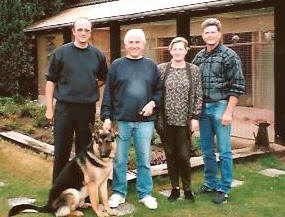
The Pigeon Vet - Nikki the dog - Antoine & Maria Jacops - Dr. John Lamberton
352 and 351 Race Winners: DIAMOMND PRINCESS & DIAMOND PRINCE
CLICK on their pictures to see pedigrees.
DIAMOND CHEX
Father of 351 and 352 Race Winners
SIRE: BLUE ACE - Full Brother To:
SUPER ACE: 2 Times 1st Ace Hafo Lier 1988 - 1989 - Antwerp Union - Belgium
DIAMOND ACE: 1st Ace Long Distance - Fond Club Antwerp Union 1992
DAM: Granddaughter WRONG WILLY and GEGSCHIFTE (Full Brothers - Meuleman)
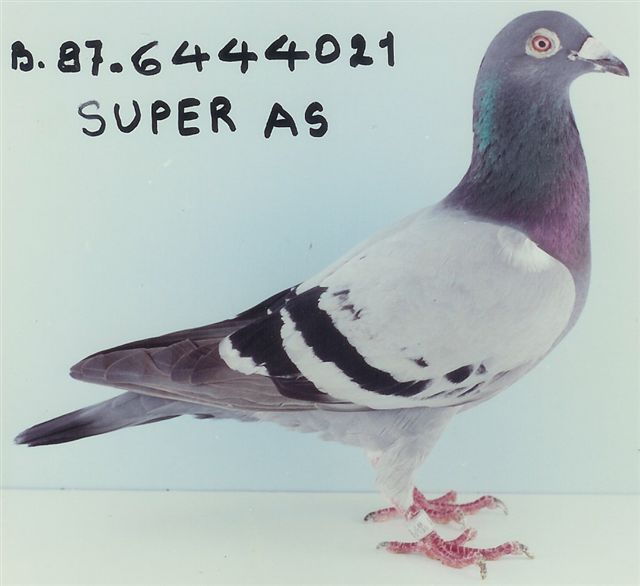
SUPER ACE: 2 Times 1st Ace Hafo Lier 1988 - 1989 - Antwerp Union - Belgium
SIRE: KLEINE CAHORS - 1st Ace Antwerp Union 1982 - Belgium - Olympiade Winner Dortmund 1987
DAM: SCHOON WITZWING - Daughter PLAYBOY (Famous Meuleman Breeder)
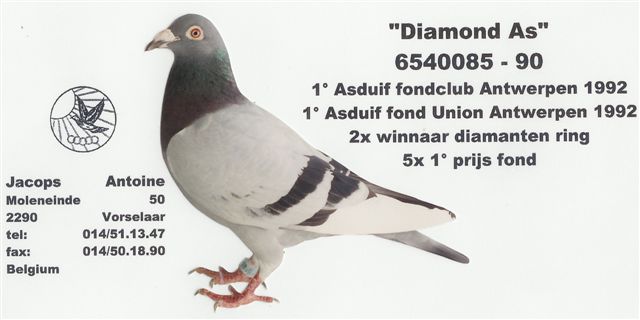
DIAMOND ACE: 1st Ace Fond Club 1992 - Antwerp Union - Belgium
SIRE: KLEINE CAHORS - 1st Ace Antwerp Union 1982 - Belgium - Olympiade Winner Dortmund 1987
DAM: SCHOON WITZWING - Daughter PLAYBOY (Famous Meuleman Breeder)

DIAMOND COUPLE: KLEINE CAHORS X SCHOON WITZWING
Produced SUPER ACE - DIAMOND ACE - WITPEN ACE & Others
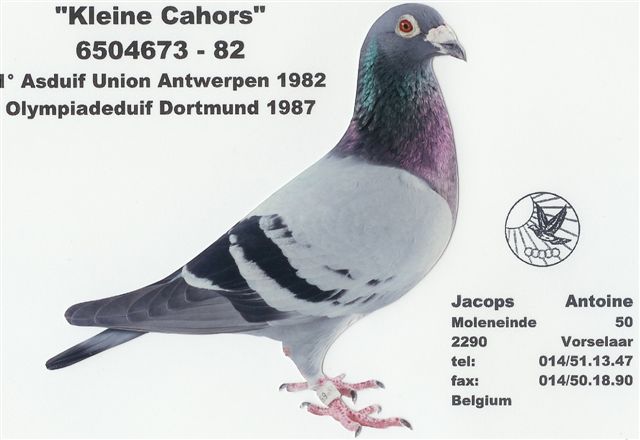
KLEINE CAHORS: 1st Ace Antwerp Union Belgium 1982 - 1st Olympiade Dortmund Germany 1987

CAHORS: Many 1st Prizes Antwerp Union
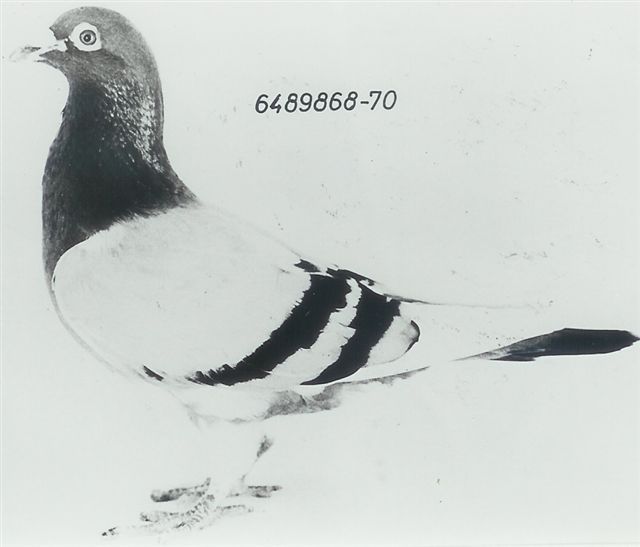
GEBROKEN POOT - Foundation Breeder and son Antoine's Foundation Breeding White male (no picture)
The pictorial spans almost 50 years of breeding and racing pigeons. There are few fanciers that can boast of this length of consistent breeding and racing success. How is this possible? After being a student of Antoine for over 20 years, I can say it's because Antoine understands the relationship between prepotency and hybrid vigor. Prepotency is a result of line-breeding and sometimes in-breeding. Hybrid vigor is a result of out-crossing. As I have indicated before, Antoine seeks a balance of 70% of his own family of pigeons and 30% outcrossing of other fancier's pigeons in his pedigrees. He only selects the very best pigeons from his own family to inbreed; and he only selects the very best pigeons from other fanciers to bring into his breeding loft from which to outcross into his outstanding family of super pigeons. In 1996, shortly before the KANNIBAAL was named 1st Ace Pigeon of Belgium, Antoine purchased an outstanding full sister from the Van Dykes. He has purchased other siblings to 1st National Aces from other outstanding fanciers as well. He has also chosen excellent breeders from the very best fanciers in Belgium. In recent years, he has bred from super pigeons from Flor Engels and Maurice Casaert, two of Belgium's hottest racing lofts. I had the great privilege of meeting Flor Engels in the early 1990s on a visit to the Engels loft with Antoine. I handled his best racers and breeders and listened very intently to everything Flor had to say. His incredible knowledge and experience came through in every word he said to me. The time spent at his loft was like gold to me and changed me as a fancier. He was an incredibly gently man with his pigeons. Yet his expectations for his racers was incredibly high. While Flor has now passed on, his sons are still racing incredibly well and their pigeons are always some of the most expensive pigeons in auctions that feature their pigeons. Several years ago, I myself paid about 2500 euro for a female that was 49th National in a prestigious race and was one-half Engels. She has bred very well for us in Belgium.
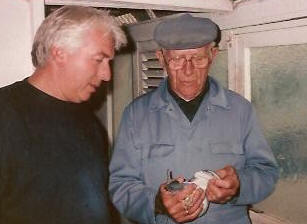
I took this picture of Flor Engels while he was showing Antoine and me a 1st National race winner and explaining to us the finer points of the pigeon. Notice Flor's posture and hands. He gently cradled the winner in his hands and slowly pointed out every feature of the bird to us. These times with legendary fanciers mentoring me were many of the best times of my life. Thank you Antoine for the marvelous gift of your tutelage and letting me share in your friendship with Flor and other great fanciers! Of course, as I always add when I speak of my past in pigeons, Mike Ganus was the key that unlocked the wonderful world of European pigeon racing for me in the early 1980s. He remains my very dear friend today and perhaps the greatest fancier of all-time for his remarkable contribution to the Pigeon Sport world-wide.
In several blogs last year, I introduced Antoine's pedigrees. If you study his pedigrees, you will discover the art form of successful breeding. While there are very successful fanciers who believe in outcrossing only, i.e., the best to the best, I believe the best to the best does not inherently mean breeding two unrelated pigeons. The best to the best can also mean coupling two pigeons of the same family that are superior racers and/or breeders. Or, it can mean outcrossing a family (A) with a new pigeon (B) and then crossing the progeny (C) back to the old family producing an outcrossed line-bred prospect which now becomes (A). I believe that the advantages of continually outcrossing for hybrid vigor in the racing loft may ultimately reduce the prepotency in the breeding loft. While there may be some of the pigeons I have purchased from Antoine that did not meet the 70/30 criteria, they were purchased while Antoine was in the outcrossing phase of his breeding program. For instance, I have an incredible female, MARIA, that is one-half Janssen from the Brothers and one-half For Engels. There is no component of Antoine's old family of pigeons in MARIA's pedigree. I purchased MARIA before Antoine could cross her into his old family. So I have continued Antoine's breeding program in Tulsa by crossing this female with several males from his old family that include a significant Flor Engel component in their pedigrees. Because I have many brothers and sisters to Antoine's top breeders in Tulsa, I often imitate Antoine's breeding program by copying his breeding couples. In act, a number of years ago Antoine and Maria visited Tulsa and stayed at our home. when he saw my pigeons, he laughed and stated that I bred better Jacop's pigeons than Jacops! Indeed, Antoine has taught me well.
Because the weather may be questionable in Northeast Oklahoma on Saturday, my friend Tony Smith of TNT Titans and I will release our young bird teams together about 50 miles south of Tulsa on the line of flight for the race course. Presently, the young birds are relaxing in a shipping crate in my truck. I am simulating the Friday night basketing procedure when the young bird race season begins by letting them sit overnight in the shipping crate. I watered the young birds in order to teach them how to drink in a shipping crate. Although the capacity of the shipping crate is about 40 birds, I always place a maximum of 25 pigeons in the crate. Currently there are 21 females in the crate. The females have been celibate all week. when they return to the loft tomorrow, they will trap into the old widowhood male section and find their mates and nest boxes. I will separate them tomorrow night. They will spend next week in a celibate section of the loft. Next Saturday, weather permitting, the young birds will once again spend the night in the shipping crate. By repeating this weekly process, the young birds will learn the nuances of the widowhood system. They will also become familiar with a shipping crate and learn to eat and drink in the crate. They will also lose their fear and learn to relax while they are crated.
Teaching your pigeons to succeed is not magic. It involves hard work, dedication, patience and a love for your birds. when I race the young birds this fall, I want to have given them every possible chance that is in my control by teaching them the nuances of the game well ahead of the race season.
TRAIN YOUR RACING PIGEONS AFFORDABLY
Because of unpredicted rain this morning, the females were only released about 10 miles south from the loft. The females returned to the old males - which was good. But, they still need a longer toss of 60 miles/96 kilometers or more. Which brings up a topic that I would like to discuss. Given the increased price of gasoline, the most economical and affordable way to train your pigeons is to road train once time per week after your birds have been tossed 10 miles in each direction from your loft: north, south, east, and west. This one week toss can be made by yourself, with a friend, with a group of friends, or as a club function. I believe that the day of each fancier training his or her racing pigeons each day or even several times a week by themselves is coming to a close. Five years ago, I taught a new graduate course for masters and doctoral students in globalization at Oklahoma State University. As a college professor, my course syllabus included the effects of globalization on energy. From that syllabus, let me mention a few facts. First, the price of gasoline is increasing dramatically because there is more demand for oil than the amount of oil currently being produced and supplied to the market. This isn't something that has just happened. It has been coming for years. It took hundreds of years for the world's population to double the first time. Now, the world's population has increased dramatically in the 20th century. Population analysts indicate that 80% of the world's population live in underdeveloped countries. As these countries' economic systems have become more active and robust, those people in underdeveloped areas want automobiles, climate control, appliances, etc. - energy consuming lifestyle just as we have here in the USA. The world's population is estimated at a little under 7 billion people. Some analysts have estimated that the world's population may reach 9 billion people by the year 2042. All of this to say that the price of oil will continue to increase over time. Oil is non-sustainable. It is a finite resource. It can't be manufactured. It is inevitable that as the world's population and lifestyle demands more energy - as the amount of cheap and easily produced oil is consumed - oil will become more and more expensive. Given this economic inevitability, what effect will the ever increasing price of gasoline have of the pigeon sport?
A secondary impact of the increased demand for oil is the price of corn used in ethanol. As you no doubt know from increased prices in your area, pigeon grain has increased 60% in 2008 in the Tulsa, Oklahoma area. Before January 2008, I could buy a 50 sack of grain for $11 to $13 per bag. Now, the price has increased to nearly $20 per sack. I believe that the ever increasing price of pigeon grain will affect the number of pigeons we maintain in our lofts. All of those "extra" pigeons will double or triple our weekly feed bill. We may start breeding from fewer couples - start raising fewer young birds - and start racing fewer pigeons. Of course, all of this has been going on in Europe for many years. That is why Belgium races as it does. Most provinces have clubs that offer short tosses of 50 or 60 miles (90 to 96 kilometers) as races. Most Belgian fanciers use these races as "training tosses." Few fanciers train by themselves and no one except Jef Cuypers and myself train around the clock. As a remedy to hedge the price increase, co-ops can be created to buy grain in large quantities from a wholesaler. No doubt this is currently happening in various parts of the USA. Much of the cost of a 50 lb sack of grain is attributable to sacking the grain. Grain purchased in bulk and kept in a large storage bin is much cheaper than "bagged" grain.
Our Sport will under going massive changes due to the increasing expense of playing the game. In order to survive and grow, fanciers will need to cooperate and work together. The club in which I race has experienced significant problems cooperating as a group. In fact, we don't cooperate in unison. I won't dignify the conflict by going into the details; but let's just say that unless we, as a Sport, value the worth of each and every fancier - unless we develop rules and policies that respect and include fanciers rather than introduce policies and rules that eliminate competition by excluding nor belittling members, the Sport will not continue wherever these conflicts occur and are not positively addressed.
DO YOU LOVE YOUR PIGEONS?
On a completely different subject, several years ago, I gave Tony Smith, a relatively new fancier, an older male and suggested that he breed as many youngsters as he could out of this remarkable bird. On Monday, TITAN, the male I gave Tony, died. He was 17 years old. While he had him, Tony raised almost 40 youngsters sired by TITAN. Tony called me in tears. TITAN was a very special bird for Tony and Josh. His children have been very good breeders; and his grandchildren have raced very well. TITAN lived in Tony's home in an unused bedroom. He never knew the scorching heat of the summer or the frigid cold of the winter. Daily Tony and Josh would talk to TITAN and care for him in his own room. TITAN'S bloodline is very robust. My 1st Ace Old Bird in the B Race Series in 2008, TRAVELER, is down from TITAN'S mother, AU 91 DULUTH 12ll.
My wish for each of us is that we develop relationships with our favorite pigeons whose life and performance move us emotionally in the same way that Tony expressed his love for TITAN. For me, this is a significant part of the best essence of the Sport; and Tony and Josh represent the meaning of true pigeon fanciers. Thank you for sharing your feelings with me Tony. You are truly a remarkable man.

I went through some of my old records. I believe that I have found a picture of the 1st National Bourges winner that Flor Engels was holding in the picture on Thursday's BLOG. On this picture, the WITTEN is on the bottom row on the left.
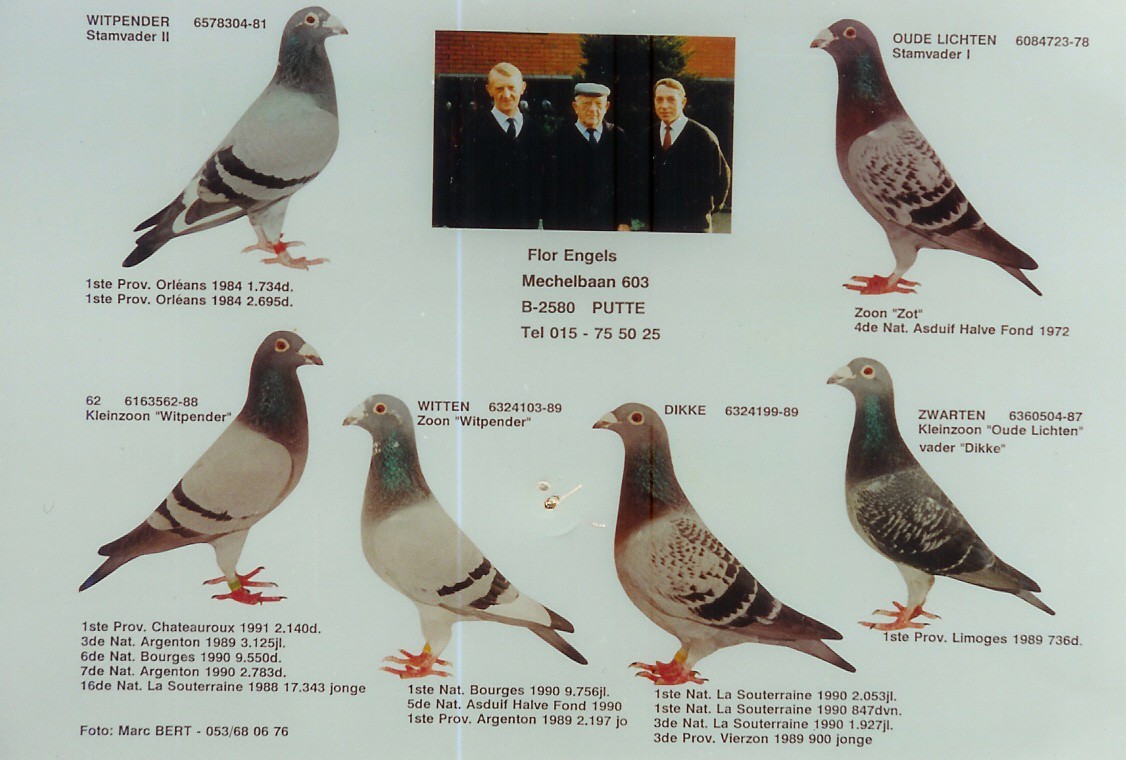
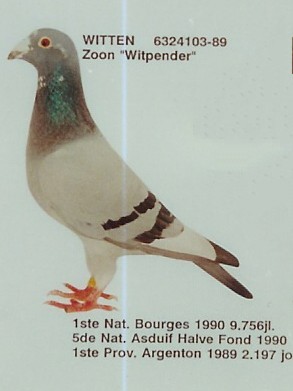
I extracted the picture of the WITTEN from the collage to show you a close-up of this marvelous pigeon. The day I was visiting Flor Engel's loft with Antoine Jacops, a Japanese fancier offered $25,000 US dollars for the WITTEN. The offer was declined.
Back to the collage picture above, the picture featured above the pigeons is Flor Engels flanked by his two sons. As I said before, Flor Engels died; but his sons continue to race very well.
There is another pigeon in the collage that is of interest. The OUDE LICHTEN, the pigeon on the upper right of the collage, is the foundation male of Engels excellent pigeons. He is also pictured below.
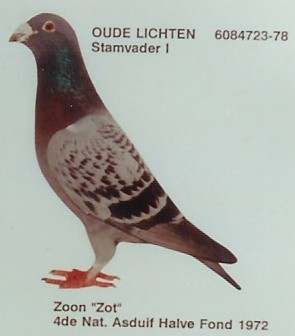
One of the top breeders Antoine Jacops has outcrossed into his family of pigeons in the past few years is the DONKERE ENGELS pictured below.
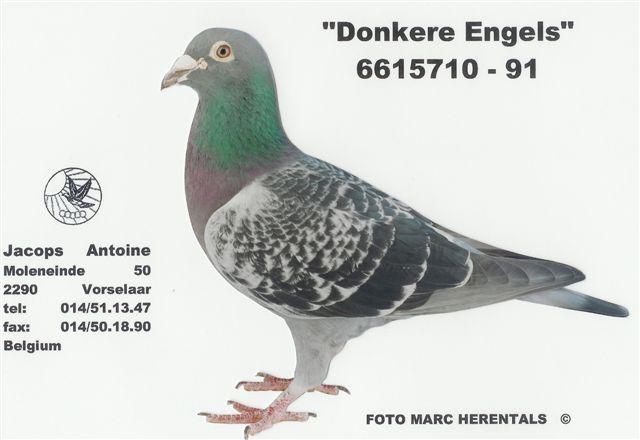
The DONKERE ENGELS is a grandson of the OUDE LICHTEN, the
basis male for the Engels discussed above. The DONKERE ENGELS is a
fantastic breeder. He has bred numerous racers that have distinguished
themselves including an Olympia Cup Winner pictured below:
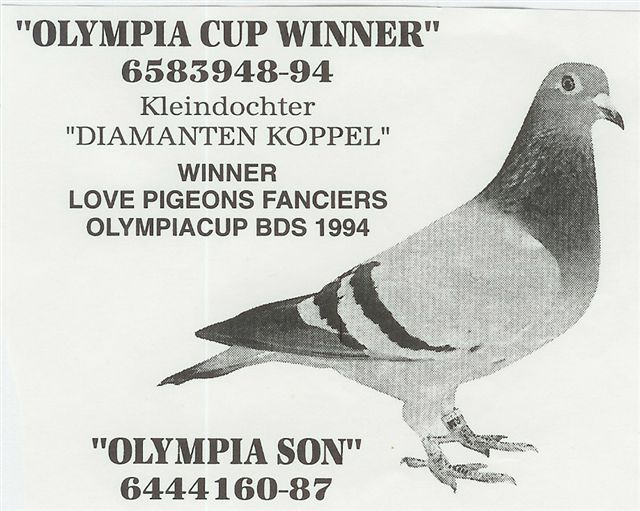
and the FONDMAN, a long distance male that has raced in the top 100 Barcelona several times in addition to other top long distance prizes. The FONDMAN is pictured below.
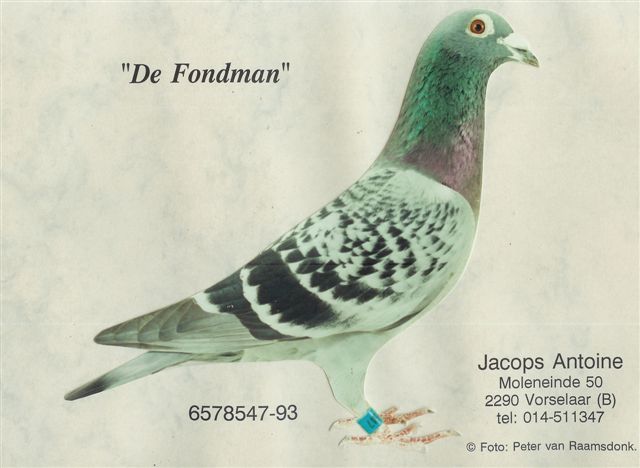
The DONKERE ENGELS is the grandfather to the NUDIST, a 2 times 1st prize winner in the Antwerp Union and one of Antoine's best widowhood males. The NUDIST came home on a race with many of his feathers gone; femalece the name the NUDIST. He is pictured below.
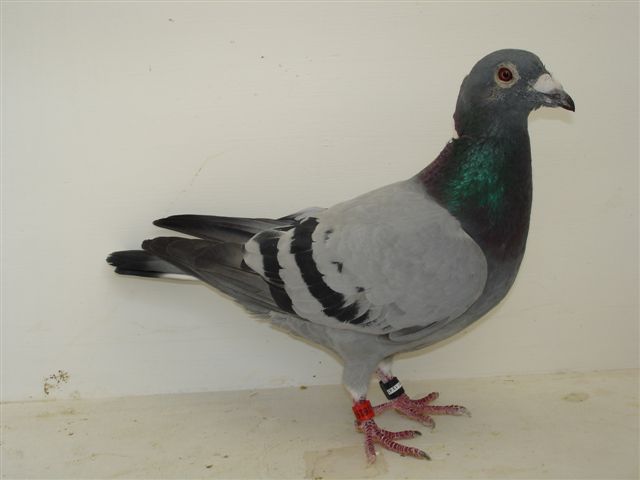
A son of the DONKERE ENGELS who is the father to the NUDIST is also pictured below.
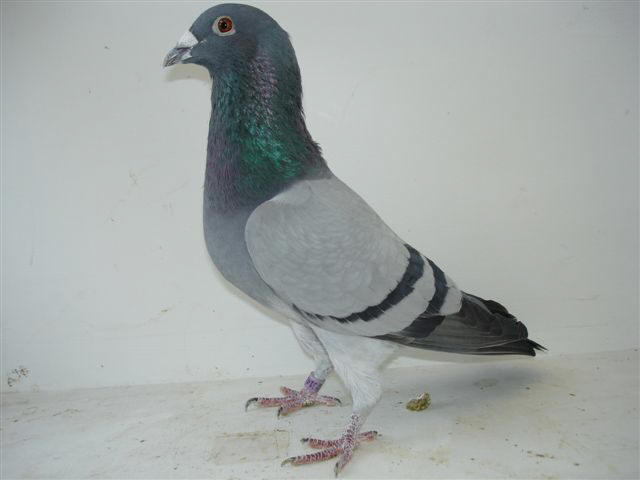
I own three incredible full brothers to the NUDIST in the loft in Tulsa and have offered for sale children out of all three of them on ipigeon. Currently, there is a very powerful young male on ipigeon sired by one of the brothers to the NUDIST - AU 08 LAMBERTON 8. Click on his picture below to see the ad on ipigeon.
Winners breed winners. AU 08 LAMBERTON 8 goes back to the OUDE LICHTEN of Flor Engels via the DONKERE ENGELS of Jacops. As I have said many times before, I have traveled throughout Belgium. Pigeon for pigeon, I believe that Antoine Jacops has a loft of some of the finest racing pigeons in the world.
One of the changes I want to bring to the Sport is an understanding and appreciation for observation, data and statistics. I guess it comes from my training as a social scientist. As I did several days ago, today I have tried to document the lineage and performance of the pigeons in my breeding lofts on my website and in this BLOG. Just because a young bird is a great son of such-n-such a pigeon doesn't mean that it necessarily will be a good one. But generations of performance, like the performance verified in today's BLOG, are what transfers both hybrid vigor and prepotency from one generation to the other. I approach the Sport as a scientist; a person who creates and then tests hypotheses - a person who creates genotype on the computer through pedigree programs as breeding pairs are coupled on paper - a person who creates pfemaleotype through my hands as I create complementary breeding pairs - a person who creates success through evaluating race results as I train my birds and give them every advantage to win. I am not afraid to offer my ideas on all aspects of the pigeon game in this BLOG and test them in my racing loft and the racing loft of other fanciers. These ideas have been passed down from generation to generation - from fancier to fancier - and fortunately, I have studied the game under many of the greats and others who were very good playing the game; but whose names are not household words.
To me, the magic of the pigeon pictured above for sale is not simply that he a young bird bred from imported pigeons. It is because he is a part of history. He is today's link in a chain that goes back many generations; a chain that was built by the hands of top fanciers like Flor Engels and Antoine Jacops. He is a result of 25 years of traveling to Belgium, building relationships with fanciers, purchasing the best pigeons possible, importing them to the USA, creating a loft in Tulsa that can compete with any loft in Belgium, breeding superior young birds in Tulsa, and offering them to the pigeon fancy in order that others may perform better as a result of these efforts. Whether or not LAMBERTON 8 will be a champion racer or breeder is yet in doubt. Much of that depends on what happens to him. Will I keep him? Will he be sold? If he sells, who will purchase him? Will the buyer give him a fair chance?
THE DEVELOPMENT AND IMPORTANCE OF PREFERENCES
Much of the training that I have received learning the qualities of great racing pigeons has been primarily a result of my friendship with Mike Ganus. Mike is one of the best pigeon graders that I have ever seen. He also understands the "business" of buying and selling pigeons. Due to his energy and expertise, the pigeon fancy in the US has benefitted greatly from the pigeons Mike has imported into the country.
Much of the training that I have received learning to play the racing pigeon game has been a result of my exposure to fanciers in the Antwerp Union in general and my friendship with Antoine Jacops in particular. I have developed my preferences from the fanciers from whom I have built relationships; particularly Jacops. Antoine and Maria let me stay at their home for many years while I shadowed Antoine in the breeding and racing lofts. On a daily basis, Antoine would let me scrape the lofts, feed and water the birds, and loft train the race birds. I often would travel to the club to enter race birds and turn in the clock after the race.
For me, racing pigeons in Belgium is a magical experience. I don't know why I feel that way. But it is so. Perhaps it has something to do with the stories my grandfather used to tell me about his grandfather and family who lived in in Scotland and Ireland before they migrated to Pennsylvania USA. The houses, streets, countryside, and people remind me of the influential stories my grandfather told me. My grandfather, John Lamberton, was the primary mentor in my life growing up. He was an independent oilman producing his own leases in and around the family's Lookout Mountain Ranch. My mother was ill and I spent much of my formative years living at my grandparents home. Granddad taught me to drive at 10 years old, wrench rods and tubing on his shallow oil wells, walk rod lines, walk lead lines, gauge oil tanks, keep records, and many other skill sets. At lunch, we would open the old black lunch box filled with my grandmother's homemade bread and pies, fried chicken, home-canned peaches, and a buffet of the most incredible food I have ever eaten. While we were eating, grandfather would talk about the old country. when I went to Belgium with Mike Ganus the first time, the experienced seemed almost familiar; probably due in part to the memories I held from my lunches with grandfather.
The reason that I relate this personal story to you is simply make the point that our preferences are usually determined by the earliest experiences we remember of something important to us. This blog is largely a product of my earliest and most memorable experiences; and the experiences that I chose to pursue once I began to play the game at a higher level. Your preferences are largely due to your earliest and most fond memories in the sport. Perhaps you had a great mentor or friend that played the game. Perhaps you began with fancy pigeons. Perhaps your father introduced you to pigeons. There are reasons how and why to found our way into the sport. These analyses of the reasons reveal the characteristics of our life path that brought us to this common place; that brought us to this blog. My preferences are no better than yours. All of us are free to play the game anyway we want. Because I am writing the blog, I am revealing my race system - my preferences - my reasons - my life story. The question is, are my methods effective? Do they create positive results, for me and for you, the reader? I am very pleased with the race results in the old bird race series. For me, they conform the voracity of the methods I am currently using to play the game. Even with these results, however, there is always something yet to discover - something yet to learn - some new young bird yet to race. The discoveries I most enjoy every year are the personalities and capabilities of the new youngsters. Will one of these new prospects develop into the most exciting pigeon that I have ever raced? That question, for me, is the most exciting questions I can ask.
Please read this blog understanding that I am not telling you how to play the game. Instead, understand that I am relating my preferences based upon my past life. If you do not prefer my preferences, so be it. The man I studied under has raced well in the Antwerp Union for many years. Last year, while he was extremely ill from maniere (an often untreatable problem with the inner ear), he was 2nd in the 2007 GOLDEN DUIF Award with Jos Thone and Eric Limbourg. With the exception, perhaps, of Michel Van Lint, are there two better fanciers in all of Belgium with which to be tied?
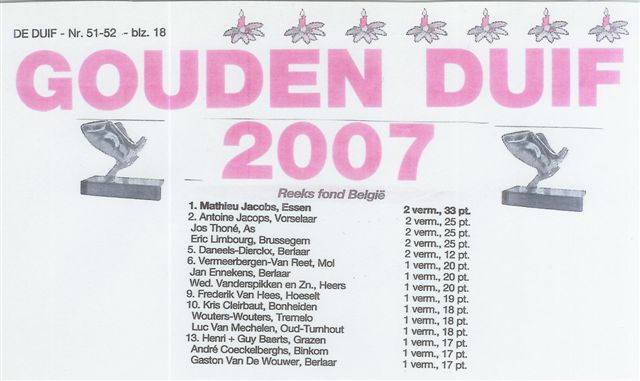
The results of Antoine Jacops in 2005 and 2006 relay a very important characteristic of his birds. Notice that the results below are for the Middle and Long distances. The Jacops pigeons race both distances equally well. They are also equally fast; and win at short distances.
1st Ace Pigeon Old Birds Long Distance Kempische Fondclub 2006
1st Ace Pigeon Old Birds Long Distance Fondclub Antwerpen 2006
1st Ace Pigeon Young Birds Middle Distance Antwerp Union 2006
4st Ace Pigeon Young Birds Middle Distance Antwerp Union 2005
5st Ace Pigeon Young Birds Middle Distance Antwerp Union 2005
By clicking on this link, you can see Antoine's best pigeons for the last years. There are brothers and sisters to these fantastic racers in Tulsa, Oklahoma, USA. The joy that Antoine and Mike Ganus have brought me with these pigeons as a result of our friendships is immeasurable. My preferences come primarily from my friendships with these two gentlemen. To read my preferences is to glimpse small parts of these two great fanciers. While reading this blog, please examine your preferences. If you are pleased with them, then my blog will be just an amusement. If you are not pleased with your preferences, try something new. Please remember my most basic tenet:
"Racing one pigeon very well is much more productive and enjoyable than racing a horde of pigeons poorly."
More to come tomorrow. Thank you. . . . . . . . . . . . . . . .Dr. John & Morgan Lamberton